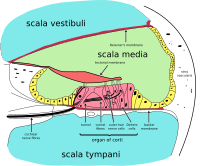
Computational cross‐species views of the hippocampal formation
Sign Up to like & getrecommendations! Published in 2023 at "Hippocampus"
DOI: 10.1002/hipo.23535
Abstract: The discovery of place cells and head direction cells in the hippocampal formation of freely foraging rodents has led to an emphasis of its role in encoding allocentric spatial relationships. In contrast, studies in head‐fixed… read more here.
Keywords: computational cross; hippocampal formation; eye head; cross species ... See more keywords

Verbal reports of neurovestibular symptoms in astronauts after short-duration space flight
Sign Up to like & getrecommendations! Published in 2018 at "Acta Astronautica"
DOI: 10.1016/j.actaastro.2018.08.028
Abstract: Abstract Because of operational constraints, no research studies are performed during return to Earth, when astronauts perform critical operational tasks such as piloting and egressing the vehicle. The objective of this study was to interview… read more here.
Keywords: verbal reports; space; space shuttle; flight ... See more keywords

Targeting head movements in humans: Compensation for disturbance from simultaneous body rotations.
Sign Up to like & getrecommendations! Published in 2018 at "Human movement science"
DOI: 10.1016/j.humov.2018.08.007
Abstract: Vestibular information plays an important role in spatially oriented motor control and perception. With regard to reorienting head movements, little is known of (1) how vestibular mechanisms compensate for disturbances from concurrent passive trunk rotations… read more here.
Keywords: head; compensation; head pointing; head movements ... See more keywords

Ampleness of head movements of children and adolescents with sensorineural hearing loss.
Sign Up to like & getrecommendations! Published in 2017 at "International journal of pediatric otorhinolaryngology"
DOI: 10.1016/j.ijporl.2016.12.015
Abstract: INTRODUCTION Head movements are controlled by the vestibular system. Children with sensorineural hearing loss can present restrictions in ampleness of head movements due to damage in the vestibule-cochlear systems, resulting from injury in the inner… read more here.
Keywords: hearing loss; ampleness head; sensorineural hearing; head movements ... See more keywords

Head Movements Allow Listeners Bilaterally Implanted With Cochlear Implants to Resolve Front-Back Confusions
Sign Up to like & getrecommendations! Published in 2018 at "Ear and Hearing"
DOI: 10.1097/aud.0000000000000581
Abstract: Objectives: We report on the ability of patients fit with bilateral cochlear implants (CIs) to distinguish the front-back location of sound sources both with and without head movements. At issue was (i) whether CI patients… read more here.
Keywords: back confusions; head movements; cochlear implants; front back ... See more keywords
Eye and head movements are complementary in visual selection
Sign Up to like & getrecommendations! Published in 2017 at "Royal Society Open Science"
DOI: 10.1098/rsos.160569
Abstract: In the natural environment, visual selection is accomplished by a system of nested effectors, moving the head and body within space and the eyes within the visual field. However, it is not yet known if… read more here.
Keywords: head; visual selection; eye head; head movements ... See more keywords

Head movements quadruple the range of speeds encoded by the insect motion vision system in hawkmoths
Sign Up to like & getrecommendations! Published in 2017 at "Proceedings of the Royal Society B: Biological Sciences"
DOI: 10.1098/rspb.2017.1622
Abstract: Flying insects use compensatory head movements to stabilize gaze. Like other optokinetic responses, these movements can reduce image displacement, motion and misalignment, and simplify the optic flow field. Because gaze is imperfectly stabilized in insects,… read more here.
Keywords: motion; motion vision; system; head movements ... See more keywords

EHTask: Recognizing User Tasks from Eye and Head Movements in Immersive Virtual Reality.
Sign Up to like & getrecommendations! Published in 2021 at "IEEE transactions on visualization and computer graphics"
DOI: 10.1109/tvcg.2021.3138902
Abstract: Understanding human visual attention in immersive virtual reality (VR) is crucial for many important applications, including gaze prediction, gaze guidance, and gaze-contingent rendering. However, previous works on visual attention analysis typically only explored one specific… read more here.
Keywords: eye head; head movements; user tasks; head ... See more keywords

Eye and head movements while encoding and recognizing panoramic scenes in virtual reality
Sign Up to like & getrecommendations! Published in 2023 at "PLOS ONE"
DOI: 10.1371/journal.pone.0282030
Abstract: One approach to studying the recognition of scenes and objects relies on the comparison of eye movement patterns during encoding and recognition. Past studies typically analyzed the perception of flat stimuli of limited extent presented… read more here.
Keywords: head; eye; panoramic scenes; head movements ... See more keywords

Inaccurate Saccades and Enhanced Vestibulo-Ocular Reflex Suppression during Combined Eye–Head Movements in Patients with Chronic Neck Pain: Possible Implications for Cervical Vertigo
Sign Up to like & getrecommendations! Published in 2017 at "Frontiers in Neurology"
DOI: 10.3389/fneur.2017.00023
Abstract: Background The primate ocular motor system is designed to acquire peripheral targets of interest by coordinating visual, vestibular, and neck muscle activation signals. The vestibulo-ocular reflex (VOR) is greatly reduced at the onset of large… read more here.
Keywords: head; suppression; eye head; gaze ... See more keywords

Spontaneous head-movements improve sound localization in aging adults with hearing loss
Sign Up to like & getrecommendations! Published in 2022 at "Frontiers in Human Neuroscience"
DOI: 10.3389/fnhum.2022.1026056
Abstract: Moving the head while a sound is playing improves its localization in human listeners, in children and adults, with or without hearing problems. It remains to be ascertained if this benefit can also extend to… read more here.
Keywords: head movements; head; hearing loss; sound localization ... See more keywords